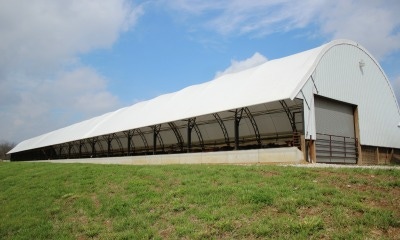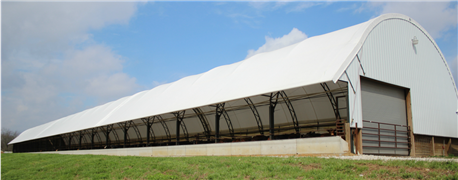
With the Missouri Beef Value Added Study showing profitability in raising cattle under roof, cattle producers may be considering these options. From open lots with shelter to completely enclosed barns, there are many options for raising cattle under roof.
Missouri Ruralist asked Jeff Windett of Hoop Beef Systems to answer some questions about one such facility--a hoop beef building.
1. What are some of the advantages to feeding under roof?

A Hoop Beef System allows you to work and manage your cattle more efficiently. It is environmentally safe. In a HBS there is no runoff because of the deep bedpack system. Healthy cattle equates to better performance. You can also utilize crop residue for a low-cost ration.
2. What class of cattle works best in a hoop system?
All classes of cattle perform at their best in our system. The flexibility of our system allows you to change from cow/calf to stockers to finishers without making any changes to the building.
3. How much land does it take for a hoop barn?
In most cases, it doesn’t require any more land than you already have on your existing farmstead. It needs to be convenient for you. It can be located near your feedstuffs, processing area and convenient for cattle loading and unloading. A site visit will be necessary to locate the facility in the best location for you.
4. What type bedding do I need to use in the bedpack?
Any type and the most economical bedding available in your area will work. That includes cornstalks, wheat straw, sawdust, corn cobs and even old fescue hay
5. How can I afford a hoop building?
Increased performance. By taking the weather off their back, cattle will improve their gains by up to 17% and feed efficiency by up to 14%. Inside a “controlled environment," you feed cattle what they need, not what they want. In addition, the manure value alone will offset the building cost. Remember, the cost of construction plus the cost of operation cannot exceed the cattle performance benefit.
6. What is the life expectancy of a hoop system?
Every HBS is engineered stamped. Meaning, every building has been reviewed for structural integrity. Every HBS comes with a 15-year warranty and carries a 90-35 rating. It is guaranteed to withstand a 90 mph straight wind and a 35 pound snow load. Every HBS is completely insurable. Steel I-beams and a double truss construction will ensure your HBS will be around for many years!
7. How do I go about starting the process of obtaining a hoop system?
The process starts by scheduling a site visit. We visit with the producers to determine the best location for the building. We also discuss the type of operation--cow/calf, feeder or finisher--and how much space is needed. Then we create an estimate for the project.
About the Author(s)
You May Also Like






